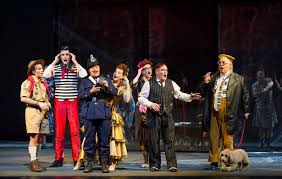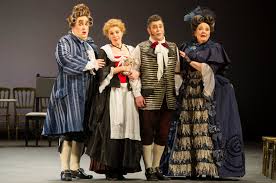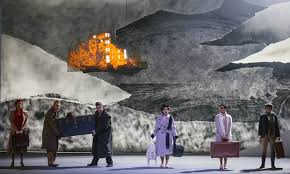Theatre Royal, Plymouth, 5-7 April 2016
Over the last three years WNO has been grouping its seasonal productions to give them some sort of internal integrity. Some of these have worked very well – I particularly enjoyed the Donizetti Tudor season which flowed like a sort of bel canto Ring cycle. Because of this, the idea of a Figaro cycle seemed an obvious choice. We have two major repertory works in The Barber of Seville and The Marriage of Figaro plus the excuse for a new commission to fill in the final chapter with Figaro Gets a Divorce. So far so good – and even better when the cycle was to be designed by Ralph Koltai throughout, which gave a visual integrity to the whole as well as being exceptionally successful at focusing our attention on the action and singers rather than the scenery.
What then was the problem? Three different directors who brought very different approaches not only to the characters, who after all remain the same throughout, but also to their dramatic style. Sam Brown appears to see The Barber of Seville as little more than an excuse for comedy, ignoring the possible psychological insights which Rossini draws on, to go instead for light comedy and sight gags. Why Almaviva is given a one-man-band in the first scene is beyond comprehension and this is only the first of many unfortunate choices – though I have to admit I loved the dogs. That the opera survives despite the weight of the comic invention is a tribute not just to the score but also to the singers. Nico Darmanin is a light but engaging Almaviva, and Claire Booth a florid Rosina who seems far too knowing (and scantily dressed) for her own good. Andrew Shore’s familiar Dr Bartolo added some weight to an otherwise rather facile concept and James Southall kept the orchestra moving with aplomb. There was no attempt to connect this with the following evening’s The Marriage of Figaro even though they are actually more closely linked in narrative than Figaro is with Divorce.
The following evening we were in a different world. This was one of the finest Figaro’s I can recall with everything falling magnificently into place, genuine ensemble playing and some of the most stylish Mozartian singing I have heard in a long time. Add to this Jeremy Sams’ witty and fluid translation, in an acoustic where every word can be heard, and it was no wonder it was all so impressive. Tobias Richter’s production seemed deceptively simple, keeping the setting within its historic period and making no attempt to be relevant or conceptual except through the interplay of the characters. In this he was highly successful and helped by Ralph Koltai’s set with its hints of below-stairs redecoration and the fading gilt of the aristocracy. Mark Stone’s Almaviva is at the heart of the evening as everything depends on his whims, which are calculated and dangerous. Elizabeth Watts’ Countess is magnificent, her two arias heartfelt and devastating in their sense of claustrophobia and despair. Anna Devin and David Stout proved to be an intelligent pair of servants as Susannah and Figaro, though they never move out of their sphere of influence. But there were no weak links in an evening of consummate artistry. I very much hope this production survives and is repeated – it certainly deserves it.
Figaro Gets a Divorce was commissioned by WNO from Elena Langer with a text by David Pountney who also directed. The score is digestible on a first hearing and has the advantage of allowing the text to be easily followed. I enjoyed much of her writing, in particular the bridge passages between scenes. There are obvious leanings towards Berg in the orchestration, with the use of accordion and percussion, while the musical line itself is post-modern enough not to upset by constant discord. Justin Brown created beautiful washes of sound from the pit, with many atmospheric moments. However there are few passages of extended melody to involve us in individual characters. Only the Countess –Elizabeth Watts, again in splendid form – and the Major, Alan Oke, have any introspective passages, while Susanna, Marie Arnet, has two cabaret songs. These cabaret songs are the closest we get to any real musical development as the Major picks up the themes and uses them as he plots the downfall of the family.
Mark Stone was again the Count, though now addicted to gambling and eventually a broken man. Figaro and Susanna do not get a divorce, though they come close to it. David Pountney’s production moves smoothly but his text frequently plods. After the wit of Jeremy Sams the previous evening it was difficult to believe that much of the text for Divorce got past the first draft. Opera for generations has been based on poetry – a setting where the words really mattered. Too often in Divorce the text was mundane to the point of discomfort, or lacked any hint of the emotional state of the character. At the interval I overheard someone say How can a work be stressful, unpleasant and boring all at the same time. We need to care about these characters. In Figaro we did; in Divorce we didn’t.
Is there a case for a Figaro cycle? Yes, I think there is. Is this the way to do it? Unfortunately not on this showing – though WNO can revive the Figaro any time they want to!



